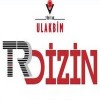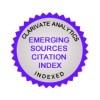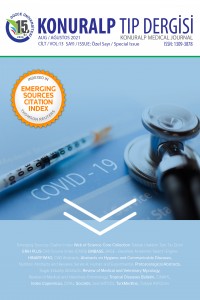Thiol-Disulphide Homoeostasis in COVID-19: Evaluation of its Relationship with Complete Blood Count Parameters
Abstract
Objective: In this study, we aimed to evaluate the relationship between thiol-disulfide homoeostasis and hemogram parameters in COVID-19 patients.
Methods: Total thiol(TT), Native thiol(NT), dynamic disulfide status(DDS), DDS/NT, DDS/TT, NT/TT ratio and CBC parameters were analyzed in 68 patients with positive COVID-19 and 31 healthy individuals.
Results: TT, NT, DD, hemoglobin and hematocrit levels were higher in the control group than in patient groups. TT, NT, DD and lymphocyte levels of COVID-19 patients treated in medical floor were higher than those treated in intensive care unit; WBC, neutrophil and NLR were low(P<0.05).PLR was higher in intensive care patients compared with the control group(P<0.05).COVID-19 patients who did not need mechanical ventilation were retrospectively evaluated according to their mortality. TT, NT, DDS and lymphocyte levels were higher; WBC, Neutrophil, PLR and NLR were lower(P<0.05) in survivors. The diagnostic performance of TT, NT and DDS levels to define requirement of intensive care treatment in COVID-19 patients were evaluated by using Receiver Operating Characteristic (ROC) curve analysis. By using ROC analysis, the optimum cut-off points for of TT, NT and DDS levels showed high sensitivity and specificity for requirement of intensive care treatment(P<0.05).
Conclusions: According to our results, it has been observed that the thiol-disulfide balance is disrupted In COVID-19 patients. It may be beneficial to monitor the thiol-disulfide balance in the follow-up and treatment of the patients.
References
- 1. Perlman S. Another decade, another coronavirus. N Engl J Med. 2020;382(8):760-62. doi: 10.1056/NEJMe2001126.
- 2. Shah SGS, Farrow A. A commentary on “World Health Organization declares global emergency: A review of the 2019 novel Coronavirus (COVID-19)”. Int J Surg. 2020; 76:128-9. doi: 10.1016/j.ijsu.2020.03.001.
- 3. Weiss SR, Leibowitz JL. Coronavirus pathogenesis, in Advances in virus research. Adv Virus Res. 2011;81:85-164. doi: 10.1016/B978-0-12-385885-6.00009-2.
- 4. Kerget B, Kerget F, Kocak AO, Kızıltunç A, Araz Ö, Uçar EY, et al. Are Serum Interleukin 6 and Surfactant Protein D Levels Associated with the Clinical Course of COVID-19? Lung. 2020;198(5):777-84. doi: 10.1007/s00408-020-00393-8.
- 5. Mathys L, Balzarini J. The role of cellular oxidoreductases in viral entry and virus infection-associated oxidative stress: potential therapeutic applications. Expert Opin Ther Targets.2016;20(1):123-43. doi: 10.1517/14728222.2015.1068760.
- 6. Pernice F, Floccori F, Nostro L, Caccamo C, Belghity N, Mantuano S, et al. Oxidative stress, sister chromatid exchanges and apoptosis in the pathogenesis of lymphocytopenia in ESRD patients. J Nephrol 2006;19(5):613-20. https://pubmed.ncbi.nlm.nih.gov/17136690/
- 7. Harrison SC Viral membrane fusion. Virology 479-480:498-507. doi: 10.1016/j.virol.2015.03.043.
- 8. Fenouillet E, Barbouche R, Jones IM. Cell entry by enveloped viruses: redox considerations for HIV and SARS-coronavirus. Antioxid Redox Signal 2007; 9(8):1009-34. doi: 10.1089/ars.2007.1639.
- 9. Ivanov AV, Eliiston VT, Ivanova ON, Kochetkov SN, Starodubova ES, Bartosch B, et al. Oxidative stress during HIV infection: mechanisms and consequences. Oxid Med Cell Longev. 2016:8910396. doi: 10.1155/2016/8910396.
- 10. Camini FC, Cameino CC, Almeida LT, de Brito Magalhães CL. Implications of oxidative stress on viral pathogenesis. Arch Virol. 2017;162(4):907-17. doi: 10.1007/s00705-016-3187-y.
- 11. Kayacan Y, Yazar H, Kısa EC, Ghojebeigloo BE. A novel biomarker explaining the role of oxidative stress in exercise and l-tyrosine supplementation: thiol/disulphide homeostasis. Arch Physiol Biochem. 2018;124(3):232-36. doi: 10.1080/13813455.2017.1388410.
- 12. Kayacan Y, Yazar H, Cerit G, Ghojebeigloo BE. A new oxidative stress indicator: Effect of 5-hydroxytryptophan on thiol-disulfide homeostasis in exercise. Nutrition.2019;63-64:114-19. doi: 10.1016/j.nut.2019.01.013.
- 13. Erenler AK,Yardan T. Clinical Utility of Thiol/Disulfide Homeostasis. Clin Lab. 2017;63(5):867-70. doi: 10.7754/Clin.Lab.2017.161117..
- 14. Erel O, Neselioglu S A novel and automated assay for thiol/disulphide homeostasis. Clin Biochem. 2014;47(18):326-32. doi: 10.1016/j.clinbiochem.2014.09.026.
- 15. Ates I, Ozkayar N, Inan B, Yilmaz FM, Topcuoglu C, Neselioglu S, et al. Dynamic thiol/disulphide homeostasis in patients with newly diagnosed primary hypertension. J Am Soc Hypertens. 2016;10(2):159-66. doi: 10.1016/j.jash.2015.12.008.
- 16. Turell L, Rad, R, Alvarez B. The thiol pool in human plasma: the central contribution of albumin to redox processes. Free Radic Biol Med. 2013;65:244-253. doi: 10.1016/j.freeradbiomed.2013.05.050.
- 17. Kumar S, Gıpta E, Kaushik S. Evaluation of oxidative stress and antioxidant status: Correlation with the severity of sepsis. Scand J Immunol. 2018;87(4):e12653. doi: 10.1111/sji.12653.
- 18. Lorente L, Martín MM, Almeida T, Abreu-González P, Ferreres J, Solé-Violán J, et al. Association between serum total antioxidant capacity and mortality in severe septic patients. J Crit Care. 2015;30(1):217.e7-12. doi: 10.1016/j.jcrc.2014.09.012.
- 19. Esen R, Aslan M, Kücükoğlu ME, Cıkman A, Yakan U, Sunnetcioglu M, et al. Serum paraoxonase activity, total thiols levels, and oxidative status in patients with acute brucellosis. Wien Klin Wochenschr. 2015;127(11-12):427-33. doi: 10.1007/s00508-015-0720-z.
- 20. Checconi P, Angali MD, Marcocci ME, Fraternale A, Magnani M, Palamara AT, et al. Redox-Modulating Agents in the Treatment of Viral Infections. Int J Mol Sci. 2020;8;21(11):4084. doi: 10.3390/ijms21114084.
- 21. Galley HF, Lowes DA, Allen L, Cameron G, Aucott LS, Webster NR. Melatonin as a potential therapy for sepsis: a phase I dose escalation study and an ex vivo whole blood model under conditions of sepsis. J Pineal Res. 2014;56(4):427-38. doi: 10.1111/jpi.12134.
- 22. Ayara G, Sahin S,Atmaca YM, Uysal Yazici M, Neselioglu S, Erel O. Thiol-disulphide homeostasis is an oxidative stress indicator in critically ill children with sepsis. Arch Argent Pediatr. 2019;117(3):143-8. doi: 10.5546/aap.2019.eng.143.
- 23. Aydogan S, Akduman H, Dilli D, Koyuncu E, Çitli R, Erel Ö, Neselioglu S, et al. The role of thiol–disulfide homeostasis in neonatal sepsis. J Matern Fetal Neonatal Med. 2019;8;1-7. doi: 10.1080/14767058.2019.1638904.
- 24. Kara S, Erel O, Demirdağ TB, Yayla BC, Gulhan B, Neselioglu S, et al. Alteration of thiol-disulphide homeostasis in acute tonsillopharyngitis. Redox Rep. 2017; 22(5):205-209. doi: 10.1080/13510002.2016.1173328.
- 25. Liu W, Li H. COVID-19: attacks the 1-beta chain of hemoglobin and captures the porphyrin to inhibit human heme metabolism. Preprint revised.2020;10 (04).
- 26. Patruta SI, Hörl WH. Iron and infection. Kidney Int Suppl. 1999;69:S125-30. doi: 10.1046/j.1523-1755.1999.055suppl.69125.x.
- 27. Rudd MJ, Good MF, Chapman DE, Powell LW, Halliday JW. Clonal analysis of the effect of iron on human cytotoxic and proliferating T lymphocytes. Immunol Cell Biol. 1990;68 (5):317-24. doi: 10.1038/icb.1990.43.
- 28. Husain N, Mahmood R. Copper (II) generates ROS and RNS, impairs antioxidant system and damages membrane and DNA in human blood cells. Environ Sci Pollut Res Int. 2019; 26(20):20654-68. doi: 10.1007/s11356-019-05345-1.
- 29. Nazima B, Manoharan V, Miltonprabu S. Oxidative stress induced by cadmium in the plasma, erythrocytes and lymphocytes of rats: Attenuation by grape seed proanthocyanidins. Hum Exp Toxicol. 2016;35(4):428-47. doi: 10.1177/0960327115591376.
- 30. Diederich L, Suvorava T, Sansone R, Keller TCS, Barbarino F, Sutton TR, et al. On the effects of reactive oxygen species and nitric oxide on red blood cell deformability. Front Physiol. 2018;11;9:332. doi: 10.3389/fphys.2018.00332.
- 31. Liu Y, Du X, Chen J, Jin Y, Jin Y, Peng L, Wang HHX, et al. Neutrophil-to-lymphocyte ratio as an independent risk factor for mortality in hospitalized patients with COVID-19. J Infect. 2020;81(1):e6-e12. doi: 10.1016/j.jinf.2020.04.002.
- 32. Mo P, Xing Y, Xiao Y, Deng L, Zhao Q, Wang H, et al. Clinical characteristics of refractory COVID-19 pneumonia in Wuhan, China. Clin Infect Dis. 2020 Mar 16;ciaa270. doi: 10.1093/cid/ciaa270.
- 33. Lagunas‐Rangel FA. Neutrophil‐to‐lymphocyte ratio and lymphocyte‐to‐C‐reactive protein ratio in patients with severe coronavirus disease 2019 (COVID‐19): A meta‐analysis. J Med Virol. 2020; 92(10):1733-4. doi: 10.1002/jmv.25819.
- 34. Tatum D, Taghavi S, Houghton A, Stover J, Toraih E, Duchesne J. Neutrophil-to-lymphocyte ratio and outcomes in Louisiana COVID-19 patients. Shock. 2020;54(5):652-8. doi: 10.1097/SHK.0000000000001585.
- 35. Xia X, Wen M, Zhan S, He J, Chen W. An increased neutrophil/lymphocyte ratio is an early warning signal of severe COVID-19. 2020;40(3):333-336. doi: 10.12122/j.issn.1673-4254.2020.03.06.
Abstract
Amaç: Bu çalışmada, COVID-19 hastalarında tiyol-disülfid homoeostazı ile hemogram parametreleri arasındaki ilişkiyi değerlendirmeyi amaçladık.
Gereç Yöntem: Total tiyol (TT), Native tiyol (NT), dinamik disülfid durumu (DDS), DDS / NT, DDS / TT, NT / TT oranı ve CBC parametreleri COVID-19 pozitif 68 hasta ve 31 sağlıklı bireyde analiz edildi.
Bulgular: Kontrol grubunda TT, NT, DD, hemoglobin ve hematokrit düzeyleri hasta gruplarına göre daha yüksekti. Serviste tedavi gören COVID-19 hastalarının TT, NT, DD ve lenfosit seviyeleri yoğun bakım ünitesinde tedavi edilenlere göre daha yüksekti; WBC, nötrofil ve NLO düşüktü (P <0.05). Yoğun bakım hastalarında PLR, kontrol grubuna göre daha yüksekti (P <0.05). Mekanik ventilasyona ihtiyaç duymayan COVID-19 hastaları mortalitelerine göre geriye dönük olarak değerlendirildi. TT, NT, DDS ve lenfosit seviyeleri daha yüksekti; Hayatta kalanlarda WBC, Nötrofil, PLR ve NLR daha düşüktü (P <0.05). COVID-19 hastalarında yoğun bakım tedavisi gereksinimini tanımlamak için TT, NT ve DDS düzeylerinin tanısal performansı, ROC eğrisi analizi kullanılarak değerlendirildi. ROC analizine göre, yoğun bakım tedavisi gereksinimi için TT, NT ve DDS düzeyleri optimum kestirim değerlerinde, yüksek duyarlılık ve özgüllük göstermiştir (P <0.05).
Sonuç: Sonuçlarımıza göre COVID-19 hastalarında tiyol-disülfid dengesinin bozulduğu görüldü. Hastaların takip ve tedavisinde tiyol-disülfid dengesinin izlenmesi faydalı olabilir.
References
- 1. Perlman S. Another decade, another coronavirus. N Engl J Med. 2020;382(8):760-62. doi: 10.1056/NEJMe2001126.
- 2. Shah SGS, Farrow A. A commentary on “World Health Organization declares global emergency: A review of the 2019 novel Coronavirus (COVID-19)”. Int J Surg. 2020; 76:128-9. doi: 10.1016/j.ijsu.2020.03.001.
- 3. Weiss SR, Leibowitz JL. Coronavirus pathogenesis, in Advances in virus research. Adv Virus Res. 2011;81:85-164. doi: 10.1016/B978-0-12-385885-6.00009-2.
- 4. Kerget B, Kerget F, Kocak AO, Kızıltunç A, Araz Ö, Uçar EY, et al. Are Serum Interleukin 6 and Surfactant Protein D Levels Associated with the Clinical Course of COVID-19? Lung. 2020;198(5):777-84. doi: 10.1007/s00408-020-00393-8.
- 5. Mathys L, Balzarini J. The role of cellular oxidoreductases in viral entry and virus infection-associated oxidative stress: potential therapeutic applications. Expert Opin Ther Targets.2016;20(1):123-43. doi: 10.1517/14728222.2015.1068760.
- 6. Pernice F, Floccori F, Nostro L, Caccamo C, Belghity N, Mantuano S, et al. Oxidative stress, sister chromatid exchanges and apoptosis in the pathogenesis of lymphocytopenia in ESRD patients. J Nephrol 2006;19(5):613-20. https://pubmed.ncbi.nlm.nih.gov/17136690/
- 7. Harrison SC Viral membrane fusion. Virology 479-480:498-507. doi: 10.1016/j.virol.2015.03.043.
- 8. Fenouillet E, Barbouche R, Jones IM. Cell entry by enveloped viruses: redox considerations for HIV and SARS-coronavirus. Antioxid Redox Signal 2007; 9(8):1009-34. doi: 10.1089/ars.2007.1639.
- 9. Ivanov AV, Eliiston VT, Ivanova ON, Kochetkov SN, Starodubova ES, Bartosch B, et al. Oxidative stress during HIV infection: mechanisms and consequences. Oxid Med Cell Longev. 2016:8910396. doi: 10.1155/2016/8910396.
- 10. Camini FC, Cameino CC, Almeida LT, de Brito Magalhães CL. Implications of oxidative stress on viral pathogenesis. Arch Virol. 2017;162(4):907-17. doi: 10.1007/s00705-016-3187-y.
- 11. Kayacan Y, Yazar H, Kısa EC, Ghojebeigloo BE. A novel biomarker explaining the role of oxidative stress in exercise and l-tyrosine supplementation: thiol/disulphide homeostasis. Arch Physiol Biochem. 2018;124(3):232-36. doi: 10.1080/13813455.2017.1388410.
- 12. Kayacan Y, Yazar H, Cerit G, Ghojebeigloo BE. A new oxidative stress indicator: Effect of 5-hydroxytryptophan on thiol-disulfide homeostasis in exercise. Nutrition.2019;63-64:114-19. doi: 10.1016/j.nut.2019.01.013.
- 13. Erenler AK,Yardan T. Clinical Utility of Thiol/Disulfide Homeostasis. Clin Lab. 2017;63(5):867-70. doi: 10.7754/Clin.Lab.2017.161117..
- 14. Erel O, Neselioglu S A novel and automated assay for thiol/disulphide homeostasis. Clin Biochem. 2014;47(18):326-32. doi: 10.1016/j.clinbiochem.2014.09.026.
- 15. Ates I, Ozkayar N, Inan B, Yilmaz FM, Topcuoglu C, Neselioglu S, et al. Dynamic thiol/disulphide homeostasis in patients with newly diagnosed primary hypertension. J Am Soc Hypertens. 2016;10(2):159-66. doi: 10.1016/j.jash.2015.12.008.
- 16. Turell L, Rad, R, Alvarez B. The thiol pool in human plasma: the central contribution of albumin to redox processes. Free Radic Biol Med. 2013;65:244-253. doi: 10.1016/j.freeradbiomed.2013.05.050.
- 17. Kumar S, Gıpta E, Kaushik S. Evaluation of oxidative stress and antioxidant status: Correlation with the severity of sepsis. Scand J Immunol. 2018;87(4):e12653. doi: 10.1111/sji.12653.
- 18. Lorente L, Martín MM, Almeida T, Abreu-González P, Ferreres J, Solé-Violán J, et al. Association between serum total antioxidant capacity and mortality in severe septic patients. J Crit Care. 2015;30(1):217.e7-12. doi: 10.1016/j.jcrc.2014.09.012.
- 19. Esen R, Aslan M, Kücükoğlu ME, Cıkman A, Yakan U, Sunnetcioglu M, et al. Serum paraoxonase activity, total thiols levels, and oxidative status in patients with acute brucellosis. Wien Klin Wochenschr. 2015;127(11-12):427-33. doi: 10.1007/s00508-015-0720-z.
- 20. Checconi P, Angali MD, Marcocci ME, Fraternale A, Magnani M, Palamara AT, et al. Redox-Modulating Agents in the Treatment of Viral Infections. Int J Mol Sci. 2020;8;21(11):4084. doi: 10.3390/ijms21114084.
- 21. Galley HF, Lowes DA, Allen L, Cameron G, Aucott LS, Webster NR. Melatonin as a potential therapy for sepsis: a phase I dose escalation study and an ex vivo whole blood model under conditions of sepsis. J Pineal Res. 2014;56(4):427-38. doi: 10.1111/jpi.12134.
- 22. Ayara G, Sahin S,Atmaca YM, Uysal Yazici M, Neselioglu S, Erel O. Thiol-disulphide homeostasis is an oxidative stress indicator in critically ill children with sepsis. Arch Argent Pediatr. 2019;117(3):143-8. doi: 10.5546/aap.2019.eng.143.
- 23. Aydogan S, Akduman H, Dilli D, Koyuncu E, Çitli R, Erel Ö, Neselioglu S, et al. The role of thiol–disulfide homeostasis in neonatal sepsis. J Matern Fetal Neonatal Med. 2019;8;1-7. doi: 10.1080/14767058.2019.1638904.
- 24. Kara S, Erel O, Demirdağ TB, Yayla BC, Gulhan B, Neselioglu S, et al. Alteration of thiol-disulphide homeostasis in acute tonsillopharyngitis. Redox Rep. 2017; 22(5):205-209. doi: 10.1080/13510002.2016.1173328.
- 25. Liu W, Li H. COVID-19: attacks the 1-beta chain of hemoglobin and captures the porphyrin to inhibit human heme metabolism. Preprint revised.2020;10 (04).
- 26. Patruta SI, Hörl WH. Iron and infection. Kidney Int Suppl. 1999;69:S125-30. doi: 10.1046/j.1523-1755.1999.055suppl.69125.x.
- 27. Rudd MJ, Good MF, Chapman DE, Powell LW, Halliday JW. Clonal analysis of the effect of iron on human cytotoxic and proliferating T lymphocytes. Immunol Cell Biol. 1990;68 (5):317-24. doi: 10.1038/icb.1990.43.
- 28. Husain N, Mahmood R. Copper (II) generates ROS and RNS, impairs antioxidant system and damages membrane and DNA in human blood cells. Environ Sci Pollut Res Int. 2019; 26(20):20654-68. doi: 10.1007/s11356-019-05345-1.
- 29. Nazima B, Manoharan V, Miltonprabu S. Oxidative stress induced by cadmium in the plasma, erythrocytes and lymphocytes of rats: Attenuation by grape seed proanthocyanidins. Hum Exp Toxicol. 2016;35(4):428-47. doi: 10.1177/0960327115591376.
- 30. Diederich L, Suvorava T, Sansone R, Keller TCS, Barbarino F, Sutton TR, et al. On the effects of reactive oxygen species and nitric oxide on red blood cell deformability. Front Physiol. 2018;11;9:332. doi: 10.3389/fphys.2018.00332.
- 31. Liu Y, Du X, Chen J, Jin Y, Jin Y, Peng L, Wang HHX, et al. Neutrophil-to-lymphocyte ratio as an independent risk factor for mortality in hospitalized patients with COVID-19. J Infect. 2020;81(1):e6-e12. doi: 10.1016/j.jinf.2020.04.002.
- 32. Mo P, Xing Y, Xiao Y, Deng L, Zhao Q, Wang H, et al. Clinical characteristics of refractory COVID-19 pneumonia in Wuhan, China. Clin Infect Dis. 2020 Mar 16;ciaa270. doi: 10.1093/cid/ciaa270.
- 33. Lagunas‐Rangel FA. Neutrophil‐to‐lymphocyte ratio and lymphocyte‐to‐C‐reactive protein ratio in patients with severe coronavirus disease 2019 (COVID‐19): A meta‐analysis. J Med Virol. 2020; 92(10):1733-4. doi: 10.1002/jmv.25819.
- 34. Tatum D, Taghavi S, Houghton A, Stover J, Toraih E, Duchesne J. Neutrophil-to-lymphocyte ratio and outcomes in Louisiana COVID-19 patients. Shock. 2020;54(5):652-8. doi: 10.1097/SHK.0000000000001585.
- 35. Xia X, Wen M, Zhan S, He J, Chen W. An increased neutrophil/lymphocyte ratio is an early warning signal of severe COVID-19. 2020;40(3):333-336. doi: 10.12122/j.issn.1673-4254.2020.03.06.
Details
| Primary Language | English |
|---|---|
| Subjects | Health Care Administration |
| Journal Section | Articles |
| Authors | |
| Publication Date | August 30, 2021 |
| Acceptance Date | July 14, 2021 |
| Published in Issue | Year 2021 Volume: 13 Issue: S1 |
Cite
Cited By
Investigation of changes in serum thiols and neutrophil-to-lymphocyte ratio, monocyte-to-lymphocyte ratio, platelet-to-lymphocyte ratio, and mean platelet volume/platelet count ratio indices in cats undergoing ovariohysterectomy
Revista Científica de la Facultad de Ciencias Veterinarias
https://doi.org/10.52973/rcfcv-e33260




